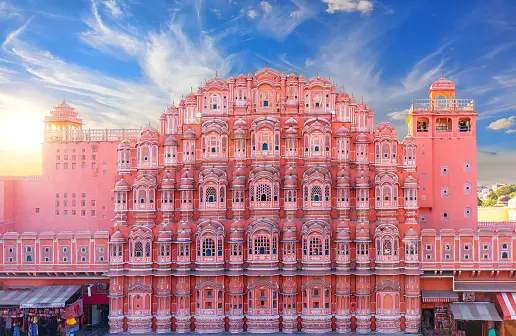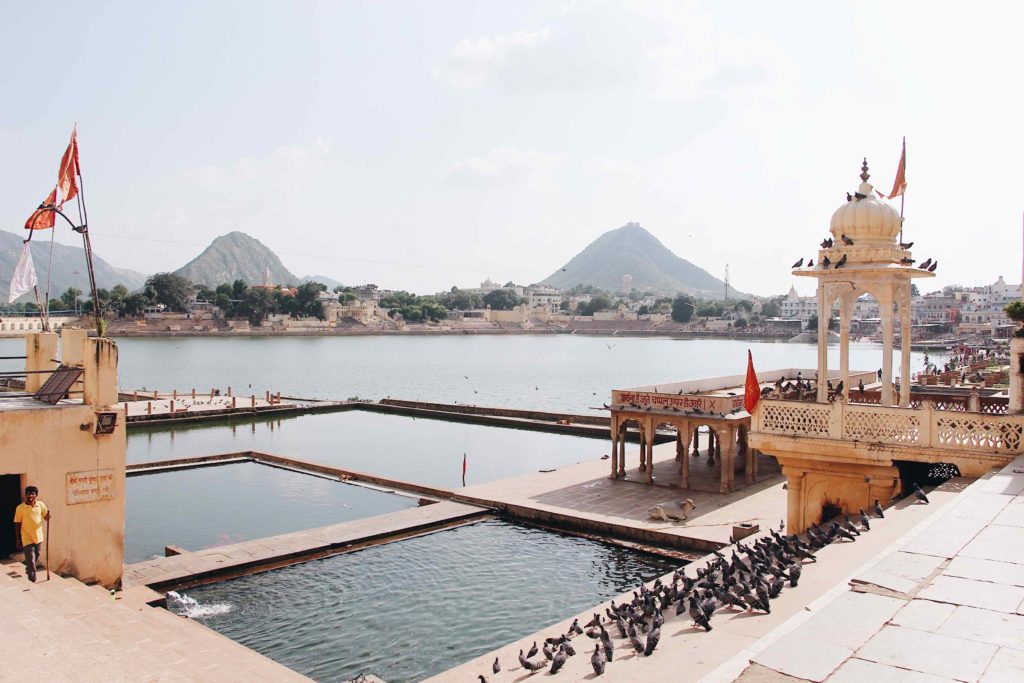

Upon your arrival, our representative will extend a warm welcome, setting the stage for your journey to the enchanting destinations of Ajmer and Pushkar. Ajmer, nestled 135 kilometers away from the vibrant city of Jaipur, beckons as a significant pilgrimage center, renowned for the revered shrine of Sufi Saint Khwaja Moinuddin Chishti. Moreover, it serves as a gateway to the mystical city of Pushkar, located just 11 kilometers away, celebrated for the illustrious Brahma Temple.
TOUR DETAILS
Ajmer Sharif Dargah
The Ajmer Sharif Dargah, a testament to spiritual significance, graces the foot of the Taragarh hill. This sacred site boasts an array of elegant white marble structures, thoughtfully arranged within two expansive courtyards. Notable landmarks include a grand gate, a generous gift from the Nizam of Hyderabad, and the Akbari Mosque, meticulously crafted by the Mughal emperor Shah Jahan. Within the premises lies the domed tomb of the venerated saint. It is worth noting that Emperor Akbar and his queen annually embarked on a pilgrimage from Agra to Ajmer, covering the journey by foot, as a testament to their devotion. Along the route, monumental pillars known as “Kose (‘Mile’) Minar” stand at intervals of two miles (3 km), marking the halting points of the royal pilgrims. The shrine attracts an astonishing 125,000 pilgrims daily, bearing witness to its spiritual magnetism.
Pushkar Lake
Nestled within the town of Pushkar, the sacred Pushkar Lake, or Pushkar Sarovar, holds a special place in the hearts of Hindus. It is enveloped by 52 bathing ghats, each comprising a series of steps leading to the pristine waters. Pilgrims congregate in significant numbers to partake in the sacred act of bathing, particularly during the auspicious Kartik Poornima period (October–November), coinciding with the renowned Pushkar Fair. A dip in the holy waters is believed to purify the soul and heal various ailments, including skin diseases. The precincts surrounding the lake embrace more than 500 Hindu temples, creating an aura of divine reverence.
As evening descends, you will return to Jaipur, concluding your memorable journey through the heartlands of spirituality and cultural richness.
# Jaipur in the 18th Century: The Pink City’s Royal Splendor
**Introductory Paragraph:**
Welcome to Jaipur in the 18th century, a city that exudes royal opulence and architectural marvels. It’s the year 1734, and the Pink City, as it’s known today, is just beginning to take shape under the reign of Maharaja Sawai Jai Singh II. Prepare to be mesmerized by the grandeur of palaces, the intricacy of craftsmanship, and the vibrant culture that thrives within these walls.
**Most Interesting People Alive:**
1. **Maharaja Sawai Jai Singh II:** The visionary ruler and founder of Jaipur, Jai Singh II, is a polymath known for his contributions to astronomy, mathematics, and architecture.
2. **Sawai Ram Singh II:** The 19-year-old ruler is about to ascend the throne, and his reign will see further development and modernization of Jaipur.
3. **Maharani Swaroop Kaur:** The queen is known for her patronage of the arts and her significant role in the city’s cultural development.
4. **Sawai Bhawani Singh:** A young prince with a promising future, he will play a vital role in preserving Jaipur’s heritage in the years to come.
**Most Interesting Sights to See:**
1. **Hawa Mahal:** Marvel at the Palace of Winds, a unique five-story structure with 953 small windows designed to allow royal ladies to observe street festivals without being seen.
2. **City Palace:** Explore the opulent royal residence, City Palace, which boasts a museum showcasing artifacts from Jaipur’s history.
3. **Jantar Mantar:** Visit the astronomical observatory built by Maharaja Jai Singh II, featuring fascinating instruments for celestial observation.
4. **Amber Fort:** Venture to the nearby Amber Fort, a majestic hilltop fortress known for its intricate mirror work and stunning architecture.
**Everyday Life:**
Jaipur in the 18th century is a hub of activity, with the bustling bazaars filled with artisans, traders, and craftsmen. The city’s inhabitants are known for their vibrant clothing, intricate jewelry, and rich cultural traditions.
**Best Foods to Eat:**
Indulge in Rajasthani cuisine with dishes like dal baati churma, gatte ki sabzi, and laal maas. Don’t forget to savor traditional sweets like ghewar and mawa kachori.
**Dangers to Be Concerned About:**
While Jaipur is a city of splendor, travelers should be wary of political intrigues and power struggles within the royal court. Additionally, keep an eye out for the vibrant but chaotic streets, as they can get crowded and potentially disorienting.
DESTINATION and TIME: Feel free to provide another historical place and time-period for me to explore.
Unveiling the Mystical History of Pushkar
Pushkar, a small town in the heart of Rajasthan, India, is steeped in history and mysticism. Known for its sacred lake, vibrant temples, and annual camel fair, Pushkar is a destination that beckons travelers seeking spiritual solace and cultural richness. In this article, we delve into the enigmatic history of Pushkar, a place where legends and traditions converge.
The Ancient Origins
The Mythical Creation of Pushkar Lake
Pushkar’s history is intertwined with the legend of Lord Brahma, the Hindu god of creation. According to Hindu mythology, Lord Brahma dropped a lotus flower from the heavens, and where it landed, Pushkar Lake was formed. This sacred lake is considered one of the most revered pilgrimage sites for Hindus and is believed to have the power to cleanse one’s sins.
The Town of Temples
Pushkar is dotted with numerous ancient temples, each with its unique significance. The most famous among them is the Brahma Temple, dedicated to Lord Brahma. It is one of the very few temples in the world dedicated to this deity. The town’s religious fervor is palpable as pilgrims and devotees throng these temples year-round.
A Center of Spirituality and Culture
The Pinnacle of Spirituality
Pushkar has long been a center for spiritual seekers and yogis. The tranquil atmosphere and the serene surroundings of the lake make it an ideal place for meditation and introspection. Many seekers from around the world visit Pushkar to attain spiritual enlightenment and inner peace.
Pushkar Camel Fair: A Cultural Extravaganza
One of the most iconic events in Pushkar is the annual Pushkar Camel Fair. This week-long festival is a kaleidoscope of colors, music, and tradition. It not only serves as a hub for camel trading but also showcases Rajasthan’s vibrant culture through folk dances, music, and traditional attire.
The Timeless Appeal
Preservation of Traditions
Pushkar’s charm lies in its ability to preserve age-old traditions and customs. The town has retained its authentic Rajasthani character, with narrow winding lanes, bustling markets, and a sense of timelessness that transports visitors to a bygone era.
A Blend of Modernity
While steeped in tradition, Pushkar has also embraced modernity. The town’s cafes, art galleries, and yoga retreats cater to the needs of contemporary travelers seeking a blend of spirituality and comfort.
In conclusion, Pushkar’s history is a fascinating journey through myths, spirituality, and cultural vibrancy. It is a place where the ancient and the modern coexist harmoniously, offering a unique experience to all who visit. Whether you seek spiritual enlightenment, cultural immersion, or simply a peaceful escape, Pushkar has something to offer every traveler. Plan your visit to this mystical town and immerse yourself in the captivating history and serene spirituality of Pushkar.
Ajmer: A Glorious Journey Through History
If you’re an enthusiast of historical narratives and cultural heritage, the city of Ajmer beckons you to embark on a mesmerizing journey through time. Situated in the heart of Rajasthan, Ajmer is a place where history, spirituality, and architecture converge to create an enchanting tapestry of the past. In this article, we will delve into the historical significance of Ajmer, exploring its rich tapestry of stories and heritage.
Ajmer’s Ancient Origins
Ajmer’s history dates back over a thousand years, with its earliest records tracing back to the 7th century AD. It was founded by Raja Ajaypal Chauhan, making it one of the oldest cities in Rajasthan. Ajmer’s strategic location on the trade route between Delhi and Gujarat further fueled its growth.
Ajmer’s Spiritual Legacy
One of the most iconic landmarks of Ajmer is the Dargah Sharif of Khwaja Moinuddin Chishti, a Sufi saint. This spiritual shrine has been a magnet for devotees from across the globe for centuries. People of various faiths visit the Dargah to seek blessings and offer their prayers.
Ajmer: The Mughal Connection
During the Mughal era, Ajmer gained immense importance. The Mughal emperors, including Akbar the Great, had a deep connection with this city. Akbar is known to have made several visits to Ajmer to seek the blessings of Khwaja Moinuddin Chishti. This historical connection between Ajmer and the Mughal dynasty has left an indelible mark on the city’s culture and architecture.
Architectural Marvels
Ajmer boasts a plethora of architectural wonders that showcase the grandeur of its bygone era. The Ajmer Fort, also known as the Taragarh Fort, is a prime example of Rajput architecture and offers panoramic views of the city. The Adhai Din Ka Jhonpra is another architectural marvel that combines Indo-Islamic design elements.
Ajmer’s Unique Culture
The vibrant culture of Ajmer is a blend of Rajasthani traditions and Sufi influences. The annual Urs festival at the Dargah Sharif is a grand celebration that attracts thousands of pilgrims and tourists. The city’s markets are adorned with colorful fabrics, handicrafts, and traditional jewelry, making it a shopper’s paradise.